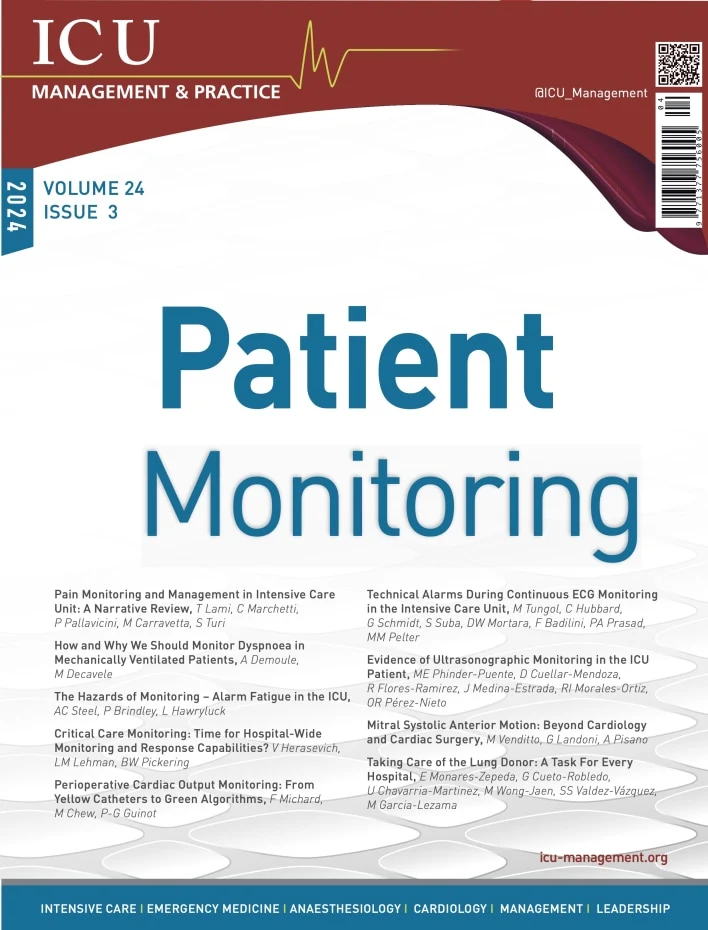
ICU Management & Practice, Volume 24 - Issue 3, 2024
Download PDF |
 |
| PRINT OPTIMISED |
Download PDF |
 |
| SCREEN OPTIMISED |
Editorial
Patient Monitoring
Patient monitoring in the ICU is critical for providing high-quality medical care. Monitoring involves continuous surveillance of physiological parameters to assess patient condition and detect signs of deterioration promptly. This includes monitoring vital signs such as blood pressure, heart rate, respiratory rate, and body temperature; continuous ECG monitoring, monitoring of respiratory parameters an...
Cover Story
Pain Monitoring and Management in Intensive Care Unit: A Narrative Review
Pain is defined as an unpleasant sensory and emotional experience. Among patients admitted to the Intensive Care Unit (ICU), severe untreated pain is associated with an increase in mortality, length of hospital stays and worsening in everyday quality of life after hospital discharge. Pain in critically ill patients is more difficult to monitor and manage due to several factors, such as the presence of...
How and Why We Should Monitor Dyspnoea in Mechanically Ventilated Patients
Dyspnoea is among the worst suffering that a human being can experience. Because mechanically ventilated patients are strongly exposed to high dyspnoea intensity, it is important that clinicians monitor dyspnoea in this population. Relieving dyspnoea in patients is a human right. Suffocating, not getting enough air or t...
The Hazards of Monitoring – Alarm Fatigue in the ICU
Alarm fatigue is a pressing clinical problem in our post-pandemic ICUs and can adversely impact patient outcomes. Its root causes can be classified by patient, device and organisation related. We believe it can be mitigated and we propose interventions through attention to policy, education and the creation of a meaningful culture of safety. "There are more things to al...
Point-of-View - Landiolol and Tachyarrhythmias
Intravenous Landiolol: Rate Control in Supraventricular Tachyarrhythmias in Patients with LVD
Athina Nasoufidou Second Department of Cardiology Aristotle University of Thessaloniki Hippokration General Hospital Thessaloniki, Greece A systematic review investigating landiolol's efficacy in non-septic or post-operated SVT patients with concomitant left ventricular dysfunction. The coexistence of heart failure (HF) and supraventricular tachyarrhythmias (SVT) exacerbates the cli...
Critical Care Monitoring: Time for Hospital-Wide Monitoring and Response Capabilities?
Physiological monitoring has a rich 200-year history. In this article, the authors look into the components of an ideal monitoring system and highlight how advancements in modern technology could enable the development of an effective continuous monitoring and response system. The continuous monitoring of patient vital signs is a required standard in acute care and procedural settings. In these s...
Perioperative Cardiac Output Monitoring: From Yellow Catheters to Green Algorithms
We discuss the economic and environmental advantages of green pulse wave analysis (PWA) techniques and the integration of PWA algorithms into standard bedside monitors that will likely contribute to democratisation of perioperative cardiac output monitoring. Haemodynamic instability frequently manifests during the perioperative course of high-risk surgical patients. This instability arises primar...
Technical Alarms During Continuous ECG Monitoring in the Intensive Care Unit
An analysis of technical alarms to guide hospital-based alarm management strategies and inform monitoring manufacturers on needed improvements to technical alarm algorithms used in bedside ECG monitors. Hospital-based electrocardiographic (ECG) monitors are configured to alarm for a number of different types of arrhythmias, ST-segment changes, and QT interval lengths that are designed to alert...
Evidence of Ultrasonographic Monitoring in the ICU Patient
Ultrasound serves as a tool to enhance diagnostic precision for decision-making in life-threatening situations in the ICU. This article will delve into the evidence of ultrasound monitoring across different scenarios. In the contemporary landscape of medical diagnostics, ultrasonography stands out as a pivotal instrument, offering a non-invasive, cost-effective, and readily accessible modality for...
Other Feature Articles
Mitral Systolic Anterior Motion: Beyond Cardiology and Cardiac Surgery
Haemodynamic instability and shock are a potential everyday challenge for intensivists and anaesthesiologists. Understanding the underlying cause is pivotal for an appropriate and successful treatment. Systolic motion of the anterior mitral valve leaflet towards the left ventricular outflow tract (SAM) is a possible insidious mechanism of low cardiac output, severe haemodynamic instability, and hypoxae...
Taking Care of the Lung Donor: A Task For Every Hospital
Every hospital can contribute to adequate lung donation. Learning and understanding the management of potential donors will allow them to receive proper care and be referred to save a life. Organ transplants are, in many cases, the only therapeutic option for patients with terminal diseases in different organs (Westphal et al. 2016). There is a marked imbalance between the number of available o...
Agenda
Upcoming Events/Congresses
19-22 NTI 2024 AACN - American Association Critical Care Nurses Denver, U.S.A https://iii.hm/1pzb 23 – 26 61st ERA Congress 2024 Stockholm, Sweden & Virtual https://iii.hm/1pzc 25-27 Euroanaesthesia 2024 Munich, Germany https://iii.hm/1pzd 29-31 35th Smart Meeting Anesthesia Resuscitation Intensive Care Milan, Italy https://iii.hm/1pze 30 – 1 JUNE LIVES Forum Confe...














